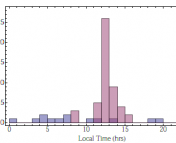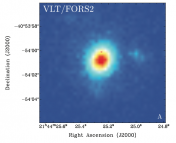Have we found the origins of fast radio bursts?
Title: Repeating fast radio burst 20201124A originates from a magnetar/Be star binary
Authors: F. Y. Wang, G. Q. Zhang, Z. G. Dai & K. S. Cheng
First Author’s Institution: School of Astronomy and Space Science, Nanjing University, Nanjing, 210093, China
Status: Nature [Submitted — Open Access]
It’s fast. It’s bright. It’s from outside our galaxy. What could it be? How about a fast radio burst! Though they were found in archival data ~15 years ago, we still know relatively little about where fast radio bursts (FRBs) originate from, and what creates them. What we do know is that they are typically extragalactic (although we saw an FRB-like burst in our own galaxy), last for a few ms (although we’ve also seen some nano-second long bursts), and are super energetic (spectral luminosities ~ 1033 erg s-1 Hz-1). We’ve seen FRBs from a range of host galaxy environments e.g., globular clusters, spiral arms, & dwarf galaxies. We’ve also seen some FRBs repeat with multiple bursts from the same sky position, and even seen some repeat periodically! But we’ve also many (the vast majority) of FRBs just once.
FRBs are interesting both in and of themselves, since we still don’t know what creates them, and as cosmological probes of the universe. While today we focus on figuring out the origins of these enigmatic events, this other Astrobite focuses on one of the cosmological uses of FRBs.
What FRB is on the menu today?
Today’s authors focus on FRB 20201124A. This repeating FRB was first discovered by the Canadian Hydrogen Intensity Mapping Experiment Fast Radio Burst Project (CHIME/FRB). It can be extremely active, with a reported burst rate of 50+ bursts/hour. After its discovery, FAST, a massive single-dish radio telescope in China, did a massive observation campaign of the source with 1800 bursts detected in a period of 88 hours. And, their findings were pretty rad! First, the FRB has the (yet to be discovered) widest burst width, with some bursts lasting for over 20 ms. Additionally, it was the first repeating FRB to show signs of circular polarization. As a throwback to E&M, circular polarization occurs when the two perpendicular electric field vectors (of the radio waves) are both equal in magnitude, and 90 degrees out of phase. Lastly, they found HUGE variations in the rotation measure of the FRB (>500 rad m-2) over the course of a day. Rotation measures are a pretty cool thing, since they are the integration of the magnetic field along your line of sight multiplied by the electron density along that line of sight (e.g., RM=Bne dl). Thus, any huge changes in the rotation measure are either due to a super rapidly changing magnetic field, or a rapid change in the electron density along the line of sight. Thus, RM information can shed a lot of light on the environment in which the FRB resides. Note that the integral of just the electron density (e.g., ne dl) is referred to as the dispersion measure.
Given these three properties, today’s authors set out to try to find a model that can fit this FRB. And they strike gold! The leading theory is… (*drumroll please*)….. a magnetar orbiting a Be star with a discretion disk (see Figure 1 below)! The best way of breaking down what this is is to take a look at a super similar system: PSR B1259-63/LS 2883.
A wonky galactic system: PSR B1259-63/LS 2883
The system PSR B1259-63/LS 2883 consists of a pulsar (a type of neutron star which emits radiation from its magnetic poles) orbiting around a high-mass Be star with a discretion disk. Wait what? Did you just misspell accretion as discretion? Nope! A discretion disk is just the opposite of an accretion disk e.g., material is emitted by the star and forms a disk around it.
So, how does this system connect back to FRB 20201124A? Well, when the pulsar is at its closest point to the Be star (known as periastron), the flux, rotation measure, degree of polarization, and dispersion measure all fluctuate! This includes the levels of linear and circular polarization. Sound familiar?
Connecting it back to FRB 20201124A
Today’s authors take the same model and fit it to FRB 20201124A. However, in order to get the emitted energy scale right, they need to up it a little, taking the orbiting star from a pulsar to a magnetar. Magnetars are neutron stars with uber strong magnetic fields, and so they have a lot more available energy because they can tap into their magnetic, rather than just rotational, energy. As shown below in Figure 2, the model of a magnetar orbiting a Be star fits the rotation measure data pretty well. However, there are some small scale fluctuations in the real data that are not encompassed by the model. These discrepancies likely arise from an uneven disk, with regions of clumpy density or magnetic field that are not well fit by their smooth disk assumption.
The discretion disk also helps to explain the large widths seen in the bursts, as there can be significant scattering within the disk which will increase the observed burst widths. Their model can also account for the circular polarization of this FRB through faraday conversion (outside the scope of this astrobite but you can get more details here).
What about other FRBs?
So, this model seems to do a pretty good job explaining the observables of FRB 20201124A, but what about other FRBs? The authors take this model and fit it to another well-known source: FRB 20190520B. This FRB is well known for rapid changes in its rotation measure, including changes in the sign of the rotation measure, which indicates that the magnetic field is changing direction. As shown below in Figure 3, given certain binary parameters (e.g., the eccentricity and period of the orbit) they can again describe the rotation measure variations using their model.
So, this model seems to pretty nicely fit two FRBs. BUT, what about the hundreds of other FRBs out there? Only time will tell… Stay tuned!
Astrobite edited by Kayla Kornoelje
Featured image credit: X-ray: NASA/CXC/Univ. of Wisconsin-Madison/S.Heinz et al; Optical: DSS; Radio: CSIRO/ATNF/ATCA




